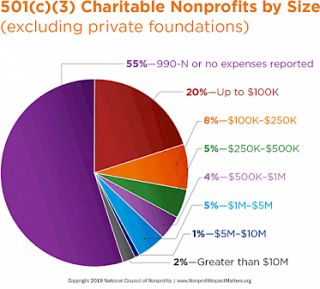While nonprofits are all around us, there are common misconceptions about what nonprofits are and what they do.
Myth: Nonprofits can’t earn a profit
Reality: The term "nonprofit" is a bit of a misnomer. Nonprofits can make a profit (and should try to have some level of positive revenue to build a reserve fund to ensure sustainability.) The key difference between nonprofits and for-profits is that a nonprofit organization cannot distribute its profits to any private individual (although nonprofits may pay reasonable compensation to those providing services). This prohibition against “private benefit” is because tax-exempt charitable nonprofits are formed to benefit the public, not private interests. For more information, see this IRS guidance. Learn about what charitable nonprofits need to do to maintain their tax-exempt status.
Myth: A well-run nonprofit should have low "overhead" costs
Reality: Operating costs, such as paying utility bills, rent, salaries, and investing in office equipment are referred to by a variety of names, including "overhead," "administrative costs," and "indirect costs." While the terminology varies, one thing does not: these costs are essential to delivering on a nonprofit's mission, and have no relation to the level of effectiveness or the outcomes a charitable nonprofit may deliver.
If you have two organizations that provide shelter and their roofs are leaking a bit (over head in the truest sense), with organization #1 doing cheap patches to keep their overhead ratio at 33 percent (but the leaks keep happening) and organization #2 has an overhead ratio of 38 percent because they replace the roof, which one is more effective? Or how about two organizations that just implemented new donor databases, one that has overhead of 31 percent and went with a cheaper, less secure solution, and the other has overhead of 37 percent because they went with one that emphasizes security. Which one do you want to donate to?
Myth: Nonprofits don’t have paid staff; they only use volunteers
Reality: According to the Johns Hopkins Center for Civil Society Studies and data from the Bureau of Labor Statistics, in 2016, nonprofits employed 12.3 million people - that's 10 percent of private employment in the United States!
Myth: Nonprofits can’t lobby
Reality: Every charitable nonprofit can and should make its voice heard on issues that are important to its mission and to the people or cause the nonprofit serves. As advocates, nonprofits are sometimes required to speak up about policies, laws, and regulations; lobbying by nonprofits is permitted by law. However, tax-exempt charitable nonprofit organizations are NOT permitted to engage in partisan political activity, such as supporting or opposing any candidate for public office. For more information on lobbying, see our advocacy resources.
Myth: Nonprofits get most of their funding from foundations
Reality: Foundation grants represent only a small part of the total amount of dollars contributed each year to the charitable nonprofit community. Private philanthropy, which includes both donations and bequests from individuals and grants from private and corporate foundations, represents only 14% of the total annual revenue to the charitable nonprofit community, and of that, the majority is from contributions from individuals.

Myth: Charitable giving incentives only benefit wealthy individuals and elite institutions
Reality: All charitable nonprofits benefit from public support and donations, and most depend on private donations to serve their communities. While an individual taxpayer only receives a partial tax benefit for charitable donations, the community served by the charitable nonprofit receives the full value of every dollar. Any cap on giving incentives negatively affect the community. For more information see our resources on charitable giving incentives.
Myth: Most nonprofits are large and have many resources
Reality: In fact, most nonprofits are small in both budget size and numbers of employees. While large, well known nonprofits, such as the Red Cross, have high visibility, those nonprofits are actually not representative of the charitable nonprofit community as a whole. 92 percent of all reporting public charities had annual revenue of under one million dollars.

